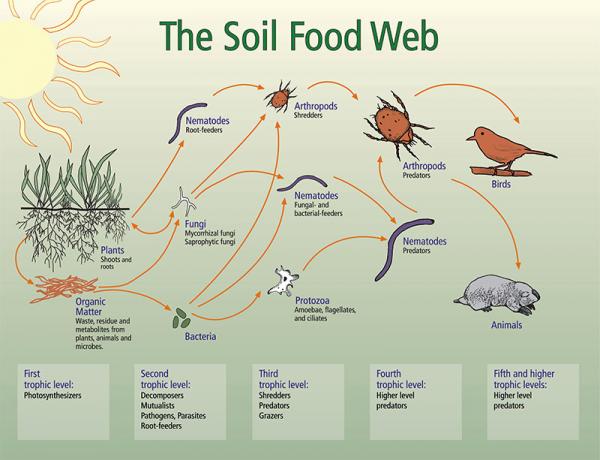A Deeper Look at Diversity
All of us in the green industry are likely familiar with the concept of diversity. Diversity is the principle that tells us the more variation we have in our landscape, the better we are able to maintain the health and function of that landscape. Normally diversity applies to different plants from different genus and species thereby avoiding monoculture and taking advantage of the variation of plant attributes. It also applies to pesticides (e.g. fungicide FRAC codes) to avoid creating pest resistance. We use diverse machinery and irrigation delivery systems too. As I have considered diversity over the years, I have come to realize diversity is far more important than I first thought, and is vital in many other areas of landscape management.
Diversity of Nutrient Cycling
 Plants need a number of elemental nutrients to sustain healthy growth. These can come from the atmosphere, the soil, or supplemented with fertilizers and are taken up by the plant in various ways. One of the most critical nutrients is Nitrogen (N). In a healthy system, N is supplied by decomposition of organic matter, deposition of atmospheric N by precipitation, fixation of atmospheric N by some plants, and some N is processed by organisms in the soil. Some cultural practices such as irrigation and chemical fertilizer affect the chemistry of the soil and can disrupt these natural nutrient cycling and availability processes. By employing cultural methods that support these natural processes, or at the least, not using cultural means that can suppress these processes, the manager can take advantage of diverse nutrient cycling systems thereby ensuring even and healthy plant growth.
Plants need a number of elemental nutrients to sustain healthy growth. These can come from the atmosphere, the soil, or supplemented with fertilizers and are taken up by the plant in various ways. One of the most critical nutrients is Nitrogen (N). In a healthy system, N is supplied by decomposition of organic matter, deposition of atmospheric N by precipitation, fixation of atmospheric N by some plants, and some N is processed by organisms in the soil. Some cultural practices such as irrigation and chemical fertilizer affect the chemistry of the soil and can disrupt these natural nutrient cycling and availability processes. By employing cultural methods that support these natural processes, or at the least, not using cultural means that can suppress these processes, the manager can take advantage of diverse nutrient cycling systems thereby ensuring even and healthy plant growth.

A comprehensive look at the nitrogen cycle. (University of Missouri graphic)
Diversity of Organisms in the Soil
Healthy soil contains many, many organisms in it. Bacteria, fungi, viruses, insects, worms, etc. all live in the soil. The vast majority of these organisms are beneficial, with only a very few being potentially damaging to turf and plants. These organisms are workhorses in the soil. They decompose organic matter, process nutrients, improve soil texture, exist in symbiosis with plant roots, and feed on and suppress pathogens. Diversity in this realm helps the soil processes functioning in balance. No one organism dominates and therefore all are kept in check. Regardless of our best efforts, many cultural practices such as pesticides, compaction, and chemical fertilizers can stress these organisms resulting in imbalances. When an imbalance creates a vacuum, something potentially unwanted may be there to fill that void. Maintaining diversity protects against imbalance.

(USDA graphic)
Diversity in Life Cycles
The environment and ecosystems that any landscape grows in has many components that all interrelate to each other in various ways. To remove any one, or several individual components, is to risk stressing the whole. This stressing can result in pest outbreaks, disease or invasive plant growth. Diversity plays a key role in filling niches that then cannot be exploited by undesirable plants or insects, or can help suppress pest populations. In a functional system, even dead plants and dead plant parts, insects, and animals play an important role in keeping the whole functioning.
Yet in the modern landscape, as soon as something dies, we remove it. I can?t help but wonder that we are lopping of an entire segment of our systems that could provide benefit in possibly unseen ways. I am not suggesting that we leave fallen trees, or road kill sitting around. I am thinking that there may be opportunity for either replacing the function by other means (compost topdressing) or possibly inoculating some wilder areas with deadfalls, leaving tree posts, brush piling, and the like. The keystone species theory says that there is likely one or two species in a system that keeps everything in balance. Enhancing diversity in life processes helps improve the odds that our landscapes will perpetuate the keystones species.
Diversity in the Workforce
I have a way of approaching my work that is largely predictable. This is not to say that I don?t get results. But my way is not always the most effective for engaging my crew. By hiring people with various strengths and thought processes, I supplement my weaknesses. The melting pot approach helps us to build camaraderie, commitment, and occasionally shared suffering. I have found that when I do things only my way, I do not maximize the results I can achieve.

The Holland Career Model illustrates workplace diversity
Diversity in a landscape in many forms is essential. Variation provides buffering against many possible negative consequences and situations. Through diversity we create attractive, healthy, and most importantly functional systems. This stability allows us to decrease maintenance and intervention, gives some predictability, and diminishes monotony. Promoting diversity is important.



0 Comments
Recommended Comments
There are no comments to display.